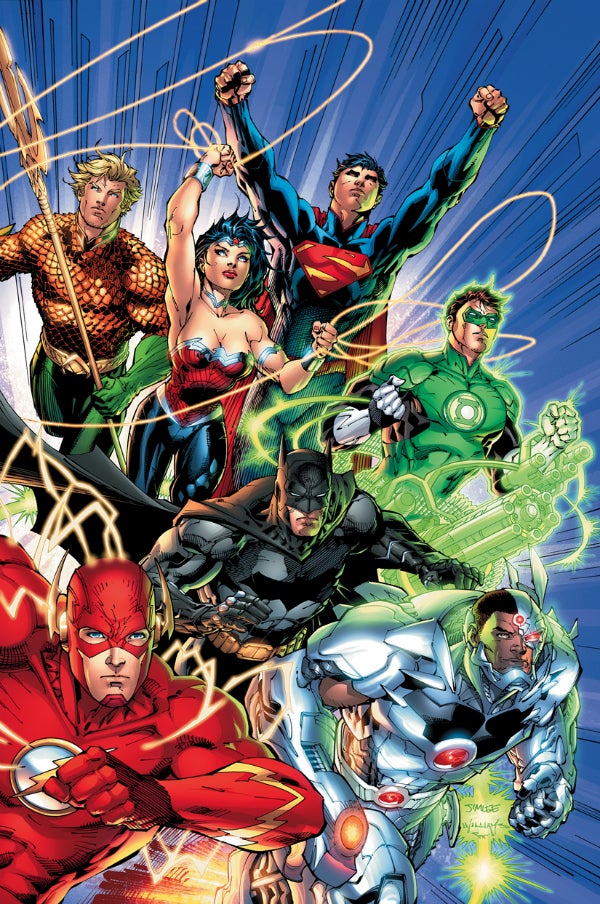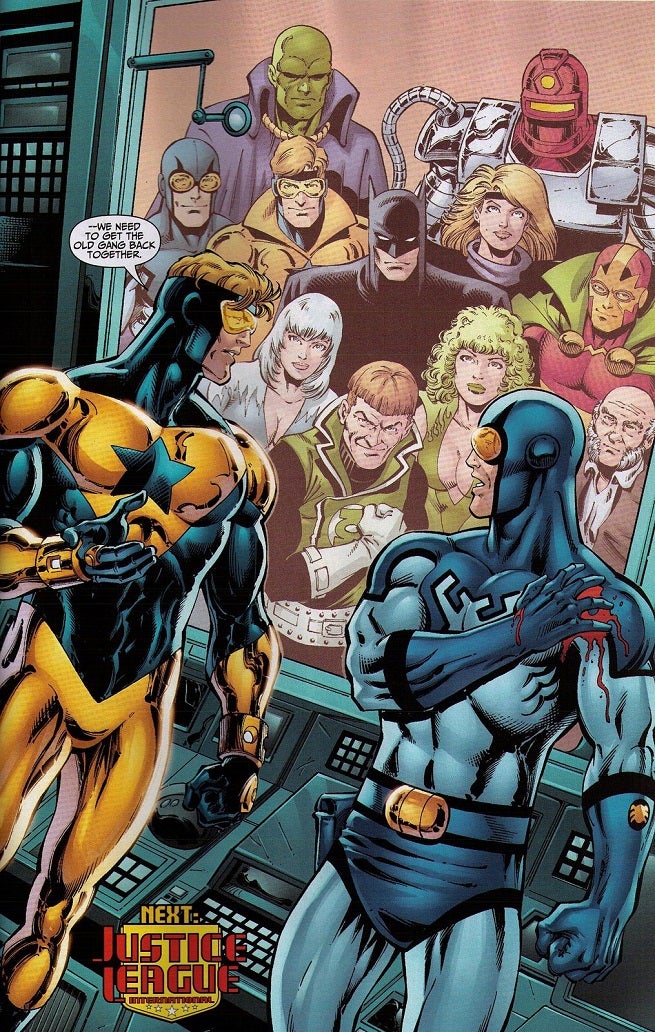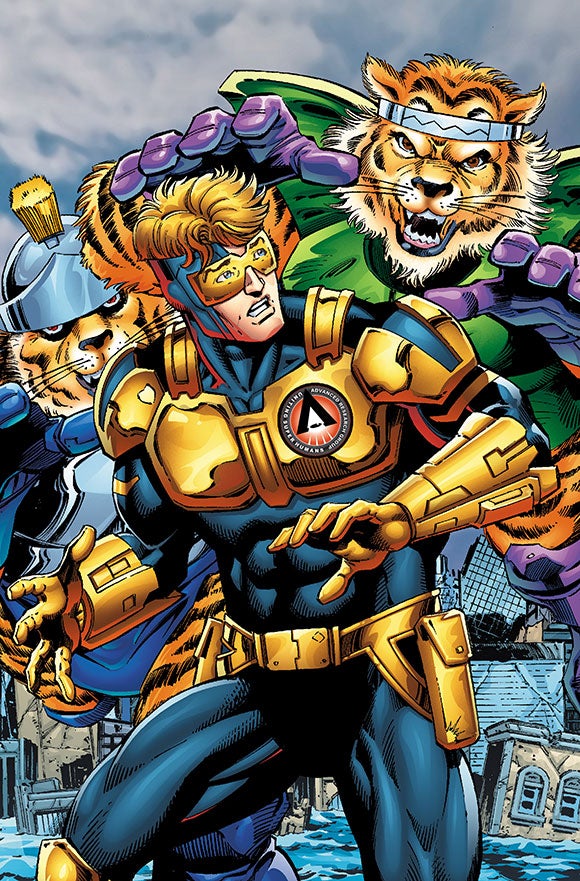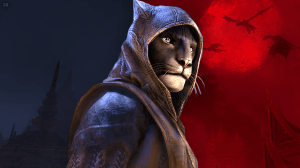
Videos by ComicBook.com
Today, with the revelation in Booster Gold: Futures End #1 and Superman: Doomed #2 that a more traditional vision of the DC Universe is out there in the multiverse somewhere, many comics fans are asking whether the New 52 is something like that.
It’s not an entirely unfair question; The New 52 has had opponents from the get-go among fans and the comics press. Virtually every DC Comics story we write will yield comments on social media demanding that the publisher go back to the pre-Flashpoint Universe, and so there is a vocal segment of the audience dissatisfied enough to lend some credibility to the idea that The New 52 is a failure, and going back an option.

Rather, it seems that this new story development — especially in Booster Gold — is in fact a direct sequel to one of DC’s most critically-lauded “event” miniseries in years, 52.
Yeah, 52 leads into The New 52. Who’d have thought?
Anyway, the Booster Gold one-shot, written by the character’s creator Dan Jurgens and featuring a number of artists including Jurgens himself, Brett Booth, Moritat and more, features an older, gruffer Time Master Booster Gold, shunted through time without coherent explanation. What he quickly realizes, though, is that he’s bouncing through the multiverse, not just time. He finds himself on worlds where he knows characters but they don’t know him, and places where characters look like they haven’t in the DC Universe for a very long time (such as the Charlton heroes’ planet, where a much more human-looking Captain Atom mistakenly unloads on Booster just before the Ted Kord Blue Beetle arrives).
What occurred to me — as somebody who conducted interviews with the creative team for nearly every issue of Booster Gold Volume 2 — is that this issue is essentially what many of us expected, and asked for, after 52.
Following the events of 52, Booster Gold and Rip Hunter had discovered the Multiverse, resurrected for the first time since the Crisis on Infinite Earths destroyed it. This was 2007 and Booster Gold was launched with the promise that he would be protecting both the timestream and the multiverse from cosmic threats.
The Multiversity, long in development from Grant Morrison, was meant to follow up the events of Countdown to Final Crisis and then Final Crisis, meaning that by the time those events were finished and Booster’s own series was hitting roughly the two-year mark, the Multiverse would have opened up to DC creators for use. Delays hampered the project, though, and DC stuck to their guns that superstar Morrison was the way to revitalize the concept of the multiverse, so outside of the occasional, odd flirtation with the concept (mostly after the New 52, when Earth 2 launched), it remained more or less dormant.
In today’s Booster Gold one-shot, there’s an overt reference to Rip and Booster having discovered the multiverse together, seemingly confirming that some version of that 52 story took place in the new canon. That’s in keeping with what Jurgens has always maintained, including when we did a commentary track on Justice League International and he affirmed for us that, yes, Booster is a Time Master and the guy we saw pop into Vanishing Point at the end of Flashpoint still exists.

During the Time Masters: Vanishing Point storyline that led into the events of Flashpoint, though, Black Beetle — who drew some of his power from a Blue Beetle scarab — managed to alter the timeline to obtain a red variation on it, doubling his power and giving his costume a red hue (kind of like the Brainiac-y word balloons at the end of the issue here).
There are, as far as we know, two disparate versions of the Older Booster who’s at the heart of most of this story. In Booster Gold Volume 2, we got a version who generally dressed in street clothes (or what passes for street clothes when you’re a Time Master) and covertly assisted his younger self and his son Rip Hunter in their time…mastery.
At the end of the Justice League International Annual that serves as the nominal lead-in to this Futures End one-shot, we got a version who has a more utilitarian version of Booster’s traditional costume, along with an A.R.G.U.S. patch on his chest, indicating that he’s working more formally with the authorities and is a respected hero as opposed to “the greatest hero you’ve never heard of,” his tagline from Volume 2.
Here’s where things get a little weird: Older Booster from pre-Flashpoint presumably doesn’t exist anymore, since the younger Booster who will turn into him was seen entering the New 52 universe at the end of Booster Gold Volume 2 and had his memories altered to reflect the changed reality around him. But Older Booster from JLI Annual, seen in today’s one-shot, tells that younger Booster that he is from a different future, that he’s an alternate version of that Booster, not the future of this world.

The fact that Booster’s long-dead sister, resurrected by Rip Hunter in Booster Gold Volume 2, remains alive certainly suggests it’s a possibility…especially because they establish that she’s the sister of Older Booster, not New 52 Booster.
And she comes from a timeline where the Daily Planet building still looks like it used to, rather than the X-shaped version we got at the start of the New 52.
At the same time, the disembodied voice that saves Brainiac at the end of Superman: Doomed seems like it’s very akin to Geoff Johns’s take on Brainiac in Action Comics, back before the relaunch (ironically, the subject of the film Justice League: Doom). His presence would explain the comments in Booster Gold about people losing their powers and cities being cut off from the rest of the world.
So…do we have a hero and a villain each from the pre-relaunch universe floating around? And could they be key to the coming Crisis?
And that’s where the New Coke thing comes in: if Flashpoint didn’t reinvent the world we’d all been reading for 20 years and instead gave us an entirely new one, then which one will end up the DC Universe at the end of the presumed New 52 Crisis event in the spring?
Well, I don’t think so. In fact, if there’s anything this current story seems to be undoing, it isn’t Flashpoint (which makes an appearance in Superman: Doomed) or the New 52. It’s Crisis on Infinite Earths, since we’re seeing some alternate earths here that we haven’t seen in-story in quite some time.
Which…well, that wouldn’t be totally out of character for DC Chief Creative Officer Geoff Johns, who seemingly prefers the Silver Age to the post-Crisis in general. He’s the guy who restored Hal Jordan and Barry Allen the first chance he got, who brought back a childhood connection between Superman and Lex Luthor and more.
That one has a lot less context, of course; most of the Doomed story was set in the New 52 and featured New 52 versions of the characters, with a follow-up planned for next week’s issues of Action Comics and The New 52: Futures End.
How we got there? Following the Doomsday/Brainiac/Superman & co. battle, the good guys threw Brainiac into a black hole, he came out with (apparently) Pre-52 Brainiac saving him and seeing the multiverse. That same word balloon — with a different color scheme — appeared in Booster Gold, suggesting that the Brainiac who was collecting cities and possibly alternate versions of himself is also the guy torturing New 52 Booster for information about Vanishing Point.
It also appears that Brainiac may be subduing the powers of those inside his collection — something that Booster somehow disrupts when he arrives. Maybe the reason people’s powers keep coming back when Booster shows up is that the time wave is disrupting whatever it is that Brainiac has going on to subdue them. Chronal energy is a powerful thing in the DC Universe, and different vibrational frequencies have been shown to have unpredictable properties (remember the Kryptonians from the post-Crisis pocket dimension whose Kryptonite didn’t affect Superman?).
In any event, the DC multiverse is back in force, and not just under Morrison’s watch but across the board. What’s next? Well, we’ll see soon enough.








